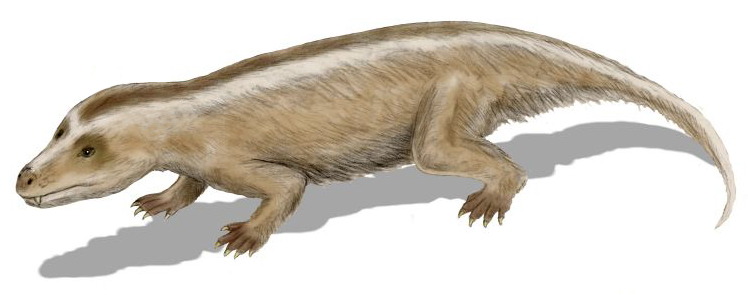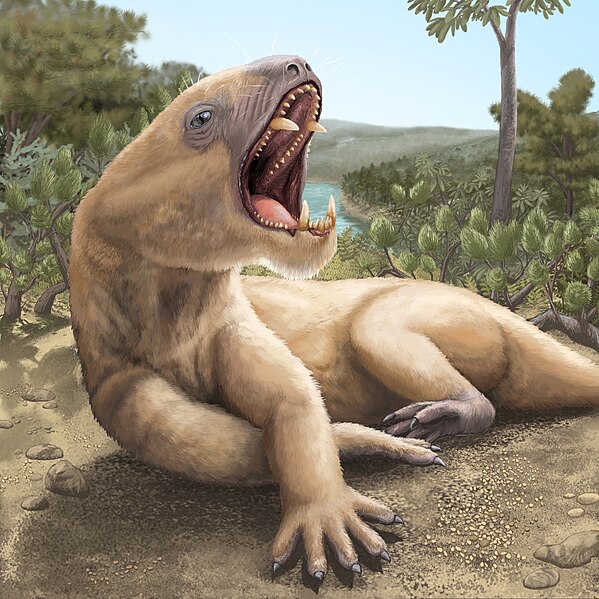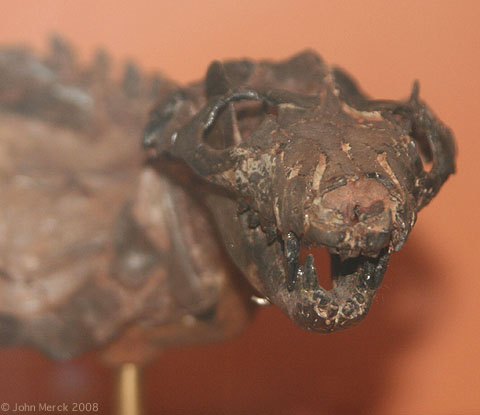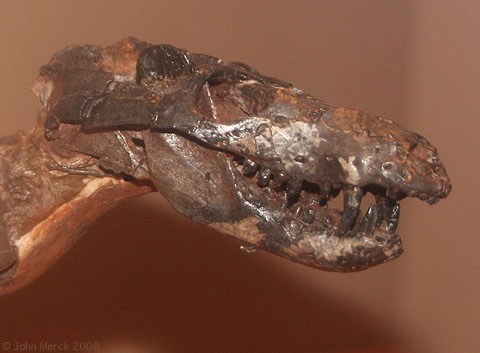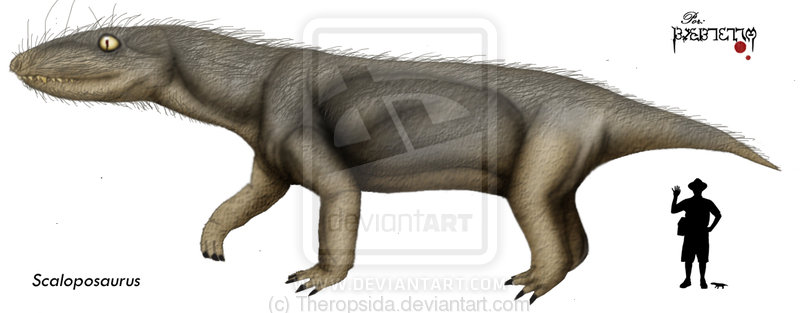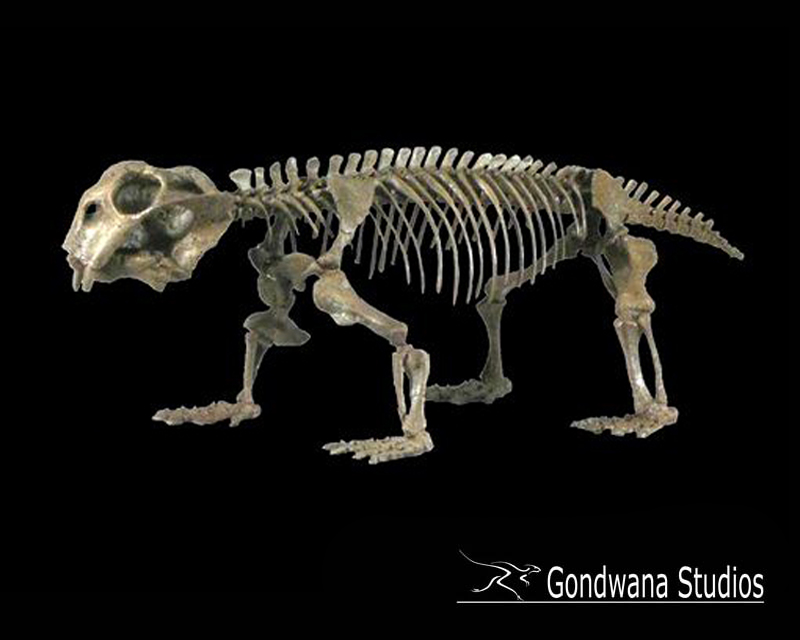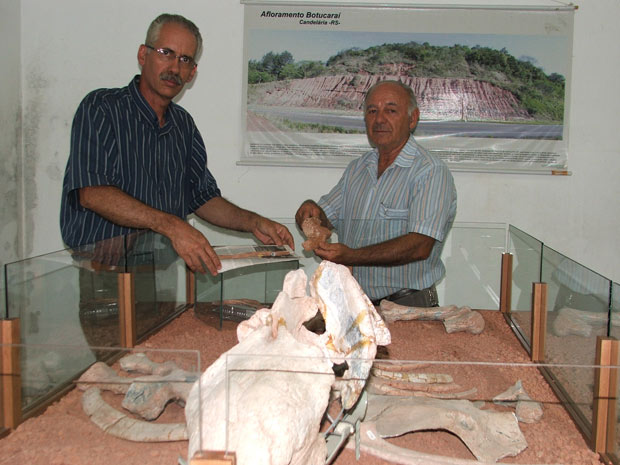[Recent Entries][Archive][Friends][User Info]
Below are the 20 most recent journal entries recorded in the "Сообщество, посвящённое ра" journal:| April 8th, 2012 | |
|---|---|
| 03:12 pm [industrialterro] [Link] |
Pachygenelus Pachygenelus is an extinct genus of tritheledontid cynodont. Fossils have been found from the Karoo basin in South Africa and date back to the Early Jurassic. Pachygenelus had both an articular-quadrate and dentary-squamosal jaw joint characteristic of ictidosaurs. Only mammals possess the dentary-squamosal articulation, while all other tetrapods possess the typical arcticular-quadrate articulation. Thus the jaw of Pachygenelus can be seen as transitional between non-mammalian synapsids and true mammals. Another feature of Pachygenelus that is shared with mammals is plesiomorphic prismatic enamel, or enamel arranged into strengthened prisms. The upper and lower tooth rows occluded with one another, although not as close as what is seen in true mammals. Wear facets are present on the lingual sides of the upper and external faces of the lower postcanines, and are seen as evidence for the occlusion. Despite all of the derived adaptation seen in its teeth, the dentition of Pachygenelus is believed to have been the least specialized of all tritheledontids. The genus was named in 1913 on the basis of a partial lower jaw found from South Africa, with the type species being named P. monus. A new species, P. milleri, was named in 1983 and distinguished from the type species in possessing an accessory posterior cusp on the lower postcanines. The use of the family Tritheledontidae to include Pachygenelus and several other chiniquodontoids has been questioned, and it has been suggested that only Trithelodon meets the qualifications required for a true tritheledontid. The authors of the paper that first proposed the idea suggested that all other tritheledontids be reassigned to a new family called Pachygenelidae, named after Pachygenelus.
Tags: Вымершие синапсиды, Юра, терапсиды |
| 02:57 pm [industrialterro] [Link] |
Tritylodon Trityldon (Greek for 3 cusped tooth) was a genus of tritylodont, one of the most advanced group of cynodont therapsids. They lived in the Early Jurassic and possibly Late Triassic periods along with dinosaurs. They also shared a lot of characteristics with mammals, and were once considered mammals because of overall skeleton construction. That was changed due to them retaining the vestigial reptilian jawbones and a different skull structure. Trityldons are now regarded as synapsids (often called "mammal-like reptiles"). If a living Tritylodon were to be seen today, it would look a lot like a large rodent. They were about 1 foot (0.3 m) long but there is no certainty about the exact weight. Also the way they ate was much like a rodent, doing a grinding motion with the bottom teeth sliding against the top teeth. The bottom teeth were much like a set of cusps and the top teeth were a set of matching grooves that matched perfectly allowing this motion. There were large incisors at the very front of their mouth separated by a gap from the rest of the teeth. Even with their mouth closed the incisors would still stick out slightly visible. The legs were directly beneath the body like mammals, unlike the earlier therapsids with sprawling limbs. These animals were burrowers; the structure of the shoulder and front limbs show this. Also the large front incisors worked very well with helping digging and getting buried plant parts. Tritylodons were strictly herbivores based on the way they ate and shape of teeth are proof. Any of the Tritylodonts including Tritylodon were warm-blooded or endothermic. Another interesting thing about them was that they were oviviparous. With partial reptile characteristics and mammal characteristics, the Tritylodon part of the Tritylodont family could be part of the link between reptiles and mammals. Some argue that Tritylodonts were too specialized, and were outcompeted by carnivorous archosaurs and other newly evolving early mammals, to become such a link. There is some possible evidence of a link to the group multituberculata. The features of the multituberculata group do match a lot of characteristics of the order Monotremata which includes the egg laying mammals: the duck-billed platypus and echidna. The Tritylodons' habitat was limited to the forests of south Africa, with other fossils found in the Mount Kirkpatrick Formation of Antarctica. When the species originated, about 200 million years ago, the African area was dryer and hotter. But for most of their existence the climate was tropical and wetter. The Tritylodon fossils in south Africa are found concentrated mainly in an area about 11,000 km² (4,250 mi²). They have been found in floodplain deposits of the Lower Jurassic Elliot Formation (upper Karoo Supergroup). In this area there have been so many findings it has been named the Tritylodon Acme Zone. The fossil findings have all been in the Orange Free State of South Africa. The genus Tritylodon of the Tritylodonts is restricted to the south African forms: Tritylodon longaevus and Tritylodon maximus. It is suggested that T. maximus is either a large T. longeavus or a closely related species. If it is a closely related species it could possiby be ecological succession since the larger T. maximus fossils have been dated in the Sinemurian–Pleisbachian mainly less than 190 million years ago and the T. longaevus in the Hettangian–Sinemurian mainly more than 190 million years ago. With the fossil findings of each species overlapping in Sinemurian stage, the fossils show two differences, T. maximus being larger and having nine upper postcanines (neither species had canine teeth) instead of the seven teeth like T. longeavus. All other structures of the two Tritylodon species were the same.
Tags: Вымершие синапсиды, Юра, терапсиды |
| 02:49 pm [industrialterro] [Link] |
Oligokyphus Олигокифус (Oligokyphus, «маленькое изогнутое животное») — одно из самых ранних млекопитающих, жившее в конце триаса — начале юрского периода. Скорее всего, является не истинным "млекопитающим", а поздним представителем обширной группы цинодонтов, давшей начало всем современным млекопитающим, но не являющейся ими. Маленькие животные, около 50 сантиметров в длину. Они имели длинное тонкое тело и напоминали по внешнему виду ласку. Конечности располагались непосредственно под телом, как и у современных млекопитающих. Особенности плечевого пояса и передних конечностей заставляют думать что этим животным приходилось копать. Эти животные были чрезвычайно активными и зарывались в опавшие листья и грязь, что свидетельствует о схожести их повадок с повадками современных грызунов и кроликов. Благодаря длинному, как у ласки, телу олигокифус мог доставать до более высоких растений, просто стоя на задних лапах. Вероятно хорошо использовал руки для употребления в пищу семян и других пищевых объектов. Олигокифус имел возможность подниматься вертикально над землёй, как некоторые современные грызуны. Обмен веществ частично или полностью эндотермической. Хотя олигокифус был очень распространен, до 1953 года не было найдено ни одного представителя этой группы. Первая информация о его находках была получена из Кайента: останки были обнаружены на гребне хребта в северо-восточной Аризоне. Многочисленные образцы олигокифуса перенаправили в Гарвардский университет и Музей Северной Аризоны «Silty Facies». Многие окаменелости были также обнаружены на территории Великобритании, Германии и в Китае. Некоторые фрагменты были обнаружены даже в Антарктиде. Одна из возможных причин вымирания этой группы животных — невозможность конкурировать с другими, позднее появившимися, млекопитающими на этой же территории. Другая возможная причина вымирания этоих животных могла быть связана с развитием новых видов растений. Появление некоторых новых видов цветковых растений, или покрытосеменных, а также развитие различных защитных приспособлений на их листьях и стеблях (колючки, эфирные масла, растительные яды и др.) могло иметь пагубные последствия для существования этих животных.
Tags: Вымершие синапсиды, Юра, терапсиды |
| 02:12 pm [industrialterro] [Link] |
Kayentatherium Kayentatherium is a genus of tritylodont, historically referred to as "mammal-like" reptiles. It is one of three tritylodonts from the Kayenta Formation of northern Arizona, United States. Kayentatherium means "Kayenta (Formation) Beast", and is named for the geological formation in which it was found. Kayentatherium is known from several specimens. It had a skull approximately 10 centimetres (3.9 in) in length. The species name honors paleontologist Samuel Welles, who worked with the University of California Museum of Paleontology in much of the pioneering work on the paleontology of the Kayenta Formation.
Ископаемые останки (1, 2, 3, 4, 5):
Tags: Вымершие синапсиды, Юра, терапсиды |
| 01:44 pm [industrialterro] [Link] |
Bienotherium Bienotherium was a therapsid from the Early Jurassic of China. Despite its size, it is closely related to Lufengia, and is the largest tritylodont from the Lufeng Formation in China. Bienotherium had four incisors, no canines, and back molar-like teeth, which it used to chew tough plant material. Bienotherium is defined as being big and robust compared to other tritylodonts, and also by exposed maxillaries in the skull, an unusually long diastema and thin zygomatic bone. Тритилодонтовые (Tritylodontydae) — небольшие и средние по размеру цинодонты (группа ископаемых животных, являющихся предками современных млекопитающих). Они были последним семейством не-млекопитающих синапсид. Будучи одной из последних существовавших линий цинодонтов, семейство Tritylodontidae были потомками циногнатоподобных цинодонтов. Тритилодонты были травоядными животными, употреблявшими в пищу растительность, такую как стебли, листья и корни. Они смогли выжить дольше всех не-млекопитающих терапсид. Они появились в конце триасового периода и существовали до юрского периода или даже до верхнего мела. Это доказывает, что тритилодонты были успешной группой терапсидов, хотя они жили прямо «под ногами» динозавров. Кроноператос, живший в палеоцене, после мелового периода и мел-палеогенового вымирания, может быть тритилодонтовым. Если так, то тритилодонты были неуловимы и редки в верхнем мелу, потому что никакие их ископаемые останки не были найдены в отложениях этого времени. Тем не менее, анатомия кроноператоса также напоминает и анатомию представителей линии млекопитающих-симметродонтов. Практически доказано, что тритилодонты были теплокровными. Окаменелости тритилодонтов были найдены в Америке, Южной Африке и Евразии. Они, возможно, смогли распространиться по всему миру, включая Антарктиду.
Tags: Вымершие синапсиды, Юра, терапсиды |
| March 30th, 2012 | |
| 07:51 pm [industrialterro] [Link] |
Purlovia Пурловия (Purlovia) — тероцефал поздней перми России. Останки найдены в Нижегородской области. Описан М. Ф. Ивахненко в 2011 году. Длина черепа 20 см. Он очень широкий из-за расширения в височной области. Посторбитальная длина составляет половину всей длины черепа, сверху череп выглядит треугольным. Зубы как у собаки. Purlovia is an extinct genus of therocephalian therapsid from the Late Permian of Russia. Together with the closely related South African genus Nanictidops, it is a member of the family Nanictidopidae. Fossils have been found from the Tonshayevsky District of Nizhny Novgorod Oblast. The type species of Purlovia, P. maxima, was named in 2011. In comparison to other therocephalians, Purlovia has a very wide skull due to a widened temporal region. Viewed from above, it looks roughly triangular. The skull is about 20 centimetres (7.9 in) long, with nearly half its length in the postorbital region behind the eye sockets. It has large canine teeth and smaller buccal, or cheek teeth, along the thick upper and lower jaws. The lower jaw is robust and curved upward, with a well-developed symphyseal region where the two halves of the jaw meet.
Tags: Вымершие синапсиды, Пермь, терапсиды |
| February 3rd, 2012 | |
| 04:25 pm [industrialterro] [Link] |
Trirachodon Трираходон — вымерший род терапсид-цинодонтов семейства Tritylodontoidea. Его ископаемые останки были обнаружены в Южной Африке; они относились к нижнему и среднему триасу. Череп трираходона имел короткую и узкую морду с широкими глазницами. Дуга щёчной кости была относительно тонкой. Среди своих сородичей цинодонтов трираходон был относительно небольшим, длина тела достигала всего 50 см. Имел меньше коренных зубов, чем его сородич Diademodon. Эти зубы, по сравнению с диадемодоном, были более широкими в поперечном сечении. Типовым видом является T. berryi, описанный в 1895 г. по основанию черепа. Ещё три образца отнесли к другому виду, T. kannemeyeri, который отличается от типового длиной основания морды и количеством постклыковых зубцов. Многие специалисты считают эти различия слишком поверхностными, чтобы выделять отдельный вид T. kannemeyeri, поэтому последний термин в современных работах выходит из употребления. Новый вид, T. minor, описал Роберт Брум в 1905 г. на основании хорошо сохранившейся морды. Позднее, в 1915 г., Брум назвал его T. browni, отличая его от других видов по длине коренных зубов. В 1932 г. Брум предположил, что T. berryi является представителем нового рода, Trirachodontoides. Ещё один вид трираходона, названный T. angustifrons, был описан в 1946 г. на основании узкого черепа, найденного в Танзании, однако позднее оказалось, что череп принадлежал скаленодону из семейства траверсодонтов. В 1972 г. было установлено, что все виды трираходона были синонимами типового вида, кроме T. browni, который был переименован в Diademodon tetragonus и отнесён к другому роду. Считается, что трираходон обитал в норах. В Намибии обнаружена серия подземных жилищ, в которых, как считается, обитали представители данного рода. В одном из таких подземных комплексов обнаружены останки как минимум 20 обитателей. Вход был с заметным склоном вниз и сводчатым потолком. Боковые камеры присоединялись к основному ходу под почти прямым углом. Трираходон имел полувыпрямленную осанку, его конечности позволяли быстро передвигаться по туннелям. Предполагается, что многочисленные останки в обнаруженной норе сохранились из-за того, что все обитатели погибли из-за быстрого затопления. Многие характеристики нор указывают на то, что в них могли обитать целые колонии. Просторный вход мог быть населён несколькими особями, а вспомогательные туннели и соответствующие камеры могли быть выкопаны одним единственным животным. Компактные этажи и двухходовые туннели свидетельствуют о том, что норы использовались множеством обитателей, которые постоянно перемещались внутри. Колониальный образ жизни трираходона позволяет предположить, что это был единственный вид из всех известных синапсид мезозоя, обладавший хорошими социальными навыками, и один из первых примеров совместного обитания в комплексе туннелей среди вообще всех известных четвероногих.
Tags: Вымершие синапсиды, Триас, терапсиды |
| 04:06 pm [industrialterro] [Link] |
Thrinaxodon Тринаксодон (Thrinaxodon, от др.-греч. θρῖναξ «трезубец» и ὀδούϛ «зуб»; правильнее было бы «тринакодон») — вымершее животное, цинодонт триасового периода, один из наиболее изученных цинодонтов. Останки обнаружены в Южной Африке и в Антарктиде, что объясняется существованием в то время единого суперконтинента Пангея. Возраст находок — 245—248 млн лет. Хищник, приблизительно 30-50 см в длину. Обладал множеством черт, присущих млекопитающим. По сравненинию с позднепермскими цинодонтами у тринаксодона эти черты выражены значительно сильнее. В то же время был яйцекладущим и сохранял значительное число других признаков рептилий. Зубы сильно дифференцированные, как у млекопитающих, но менялись в течение всей жизни, как у рептилий; характерный прикус млекопитающих (окклюзия) отсутствовал. Как и у млекопитающих, грудь и брюшная полость были, вероятно, разделены диафрагмой. Впервые у позвоночных появляется чёткое разделение грудной и тазовой областей туловища. Ямки на черепе позволяют предположить наличие вибрисс и, как следствие, то, что тело тринаксодона было покрыто шерстью. Всё это имело большое значение для выработки теплокровности. Возможно, тринаксодон был телокровным, хотя этого и нельзя утверждать с определённостью. Тринаксодон входил в состав биоценоза, сформировавшегося после массового пермского вымирания. Жил в неглубоких норах, вырытых в склонах холмов или в берегах рек. Было обнаружено множество следов роющей деятельности тринаксодонов, их останки были найдены в слепках нор в отложениях речной долины. Рацион мог состоять из насекомых, мелких позвоночных и других мелких животных.
Ископаемые останки (1, 2, 3, 4):
Tags: Вымершие синапсиды, Триас, терапсиды |
| 03:48 pm [industrialterro] [Link] |
Stahleckeria Шталекерия (Stahleckeria) — гигантский дицинодонт середины триаса. Шталекерия относится к группе дицинодонтов-каннемейерид. Длина черепа около 60 см, общая длина до 3 метров. Тело высокое, массивное, короткие толстые ноги с мощными плоскими когтями. Голова округлая, очень широкий затылок. Клыки и прочие зубы отсутствуют. Вместо клыков — тупые костные выросты верхней челюсти. Питалась низкорослой растительностью. 2 вида, из среднего триаса Бразилии. Родственный шталекерии некрупный дицинодонт элатозавр найден в среднем триасе Поволжья. Родственником шталекерии может быть и самый крупный из восточноевропейских триасовых дицинодонтов — Elephantosaurus jachimovitschi. Он известен по обломку черепа из ладинского яруса (средний триас) Башкирии. Длина черепа этого животного могла быть до 1 метра.
Tags: Вымершие синапсиды, Триас, терапсиды |
| February 2nd, 2012 | |
| 09:14 pm [industrialterro] [Link] |
Sinokannemeyeria Sinokannemeyeria was a large (about 6 feet (1.8 m) long and weighing 250 pounds), long snouted, Chinese dicynodont with downward-pointing tusks that grew from bulbous projections on its upper jaw. The muscle attachment sites on the back of the skull were quite small, which suggested that Sinokannemeyeria did not have powerful skull muscles for shearing plants, unlike other dicynodonts. Most dicynodonts chopped up food by sliding their lower jaws backward and forward. Sinokannemeyeria fed by tearing plant material with the front of the snout. Sinokannemeyeria and the other kannemeyeriines descended from ancestors similar to Lystrosaurus.
Tags: Вымершие синапсиды, Триас, терапсиды |
| 09:07 pm [industrialterro] [Link] |
Scaloposaurus Scaloposaurus is an extinct carnivorous genus of therocephalian living during the Triassic 251.0—245.0 Ma existing for approximately 5 million years. Scaloposaurus was named by Owen (1876). It is not extant. It was assigned to Therocephalia by Broom (1913); and to Scaloposauridae by Carroll (1988).
Tags: Вымершие синапсиды, Триас, терапсиды |
| 08:57 pm [industrialterro] [Link] |
Rabidosaurus Rabidosaurus is an extinct genus of dicynodont of the family Kannemeyeriidae. Рабидозавр (Rabidosaurus ) - крупный зверообразный ящер из группы аномодонтов-страннозубов. Длина черепа этого рода доходила до 57 см. У большинства аномодонтов от зубов остались только очень крупные клыки в верхней челюсти, иногда достигавшие почти полуметра в длину; некоторые аномодонты не имели зубов вообще. Крупные аномодонты были размером с быка, их массивное неуклюжее тело покоилось на коротких толстых ногах, хвост тоже был короткий. Конец морды был одет роговым клювом, в сочетании с торчащими из пасти клыками и рогами, венчавшими головы некоторых из аномодонтов, он придавал им вид фантастических химер. Тем не менее, эти животные существовали и были очень многочисленны, особенно в перми и триасе Южной Африки. К аномодонтам относится и знаменитый листозавр, вездесущее животное, остатки которого найдены на всех континентах, даже в Антарктиде. Мы еще плохо представляем себе образ жизни аномодонтов; одни ученые считали, что они были плотоядными, питались падалью, другие, что это - растительноядные формы. Последнее предположение более вероятно. Остатки рабидозавра найдены в триасовых отложениях Восточной Европы, он жил 230 миллионов лет назад.
Tags: Вымершие синапсиды, Триас, терапсиды |
| 06:39 pm [industrialterro] [Link] |
Probelesodon Probelesodon is an extinct genus of chiniquodontid cynodont. Fossils have been found from Argentina and Brazil of Triassic age. Specimens were first discovered from the Chañares Formation in La Rioja Provence, Argentina that date back to the Anisian stage of the early Middle Triassic. A new species, P. sanjuanensis, was named in 1996 on the basis of a skull found from the Ischigualasto Formation. This extends the temporal range of Probelesodon into the Carnian stage of the Late Triassic. The occurrence of the genus in these strata suggests that it also existed during the deposition of the Los Rastros Formation, which also outcrops in the same area as the localities where fossils have been found, although specimens have yet to be found from this formation. The presence of the genus in the Ischigualasto Formation is restricted to the earlier strata, becoming completely extinct soon after along with the last of the carnivorous cynodonts in the area. This has been taken as evidence for the gradual replacement of therapsid fauna with the later mainly archosaur-dominated faunas of the Late Triassic. Evidence from the Chañares Formation also seems to support this faunal transition. The type species of Probelesodon is P. lewisi from the Chañares Formation. This species is the best known as many relatively complete specimens have been found. A long secondary palate distinguishes it from other closely related genera such as Belesodon. The molars are multicuspidate and the main cusps curve back. One species, P. sanjuanensis, differs from other species of Probelesodon by such characteristics as a highly arched zygomatic arch and the presence six postcanines. Another species, P. kitchingi was named in 1982 from material found from Rio Grande do Sul, Brazil. P. minor is similar in appearance to the type species and has been found from the same formation. It differs mainly in size, being about half the length of the type species. This size difference is too great to be considered sexual dimorphism. The close similarities between all four species have led to recent suggestions that they are synonymous with one another. It has even been suggested that the entire genus is synonymous with Chiniquodon theotonicus.
Tags: Вымершие синапсиды, Триас, терапсиды |
| 06:21 pm [industrialterro] [Link] |
Placerias Плацериас (Placerias) — гигантский дицинодонт, живший в конце триасового периода, 221 - 210 миллионов лет назад. Известен из карнейских отложений Северной Америки. Особенно характерен для фауны Чинле в Аризоне («Каменный Лес»). Плацериас принадлежит к семейству Kannemeyeridae, являясь поздним крупным представителем этой группы. Длина черепа превышала 60 см, общая длина доходила до 3,5 метров, а высота — 1,6 метра. Масса животного достигала 1 тонны. Череп высокий и широкий, с высоким затылочным гребнем. Характерен обычный для дицинодонтов роговой клюв. Клыки редуцированы, но чрезвычайно развиты бивнеподобные выросты челюстных костей (особенно у самцов). Судя по строению затылочной области, животное было приспособлено к питанию какой-то надземной растительностью, «бивни» могли служить для сдирания коры. Тело почти шарообразное, конечности очень мощные, хвост короткий. Вели стадный образ жизни, обычно это обосновывают нахождением остатков множества особей в одном месте, но более важно наличие заметного диморфизма в развитии «бивней» у разных особей. Это последний из дицинодонтов Северной Америки. Описан Лукасом в 1904 году, один вид — P. hesternus. В трибу Placerini входят еще два рода дицинодонтов — могреберия (Moghreberia) из позднего триаса Марокко и ишигуаластия (Ischigualastia jenseni) из карнея Аргентины. Эти крупные дицинодонты сходны с плацериасом, отличаясь деталями строения черепа (в частности, могреберия сохраняет настоящие клыки, а у ишигуаластии клыков нет, выросты челюстных костей развиты слабее, чем у плацериаса). Ишигуаластия — самый крупный из известных дицинодонтов, весом более 1 тонны. Плацериасы и их родичи были, вероятно, основной добычей гигантских крокодиломорфов — равизухий и престозухий, известных из тех же отложений карнейской эпохи. Из среднего триаса (донгуз) Оренбургской области известны обломки верхнечелюстного «бивня» некрупного дицинодонта, сходного с плацериасом. Он получил название Edaxosaurus edentatus.
Репродукции (1, 2, 3, 4, 5, 6):
Tags: Вымершие синапсиды, Триас, терапсиды |
| February 1st, 2012 | |
| 07:29 pm [industrialterro] [Link] |
Massetognathus A relative of Cynognathus, Massetognathus was a plant-eating cynodont belonging to the Traversodontid family. This cynodont lived in what is now South America, in Brazil (paleorrota) and Argentina (Los Chañares Formation) during the Middle Triassic period (220 million years ago). Massetognathus was about 50 centimetres (1.6 ft) long. It had cheek teeth specially adapted to chewing on vegetation. It still had the distinctive long snout of its cynodont relatives, with nipping incisors and fang-like canines, but its cheek teeth were not pointed. Instead they were flat-topped and were covered with a number of low ridges, which made them good for grinding any stems, roots and other plant materials. Massetognathus had clawed feet and a long dog-like tail. Like most of its cynodont relatives, it may have been covered in hair.
Tags: Вымершие синапсиды, Триас, терапсиды |
| 06:14 pm [industrialterro] [Link] |
Lystrosaurus Листрозавры (Lystrosaurus) — раннетриасовые дицинодонты. Листрозавры были среди немногих дицинодонтов, выживших во время пермотриасового кризиса. От других дицинодонтов их отличает высокий укороченный череп с вынесенными наверх ноздрями и глазами. Как и у многих других дицинодонтов, у листрозавров из всех зубов сохранились лишь два верхних клыка. Челюсти, вероятно, были одеты роговым клювом. Ноги короткие и массивные. Листрозавров долгое время считали полуводными животными, вроде гиппопотамов. Сейчас предполагают, что они жили в полупустынях раннего триаса и выкапывали пищу (возможно, корни растений) из земли с помощью клыков. Остатки листрозавров были впервые найдены в Южной Африке в 50-х годах XIX века. В настоящее время известно, что листрозавры населяли в самом начале триаса всю Пангею. Они были доминирующими растительноядными той эпохи, дав своё имя первой зоне эпохи нижнего триаса (зона Lystrosaurus). Их кости обнаружены в Антарктике и на севере России, а также в Китае и Индии. Всего описаны 13—14 видов. Длина черепа у разных видов от 12 до 40 см, длина тела могла достигать 2 м. Листрозавры — возможные предки крупных триасовых дицинодонтов — каннемейерий. Lystrosaurus was a pig-sized dicynodont therapsid, typically about 3 feet (0.9 m) long and weighing about 200 pounds (90 kg). Unlike other therapsids, dicynodonts had very short snouts and no teeth except for the tusk-like upper canines. Dicynodonts are generally thought to have had horny beaks like those of turtles, for shearing off pieces of vegetation which were then ground on a horny secondary palate when the mouth was closed. The jaw joint was weak and moved backwards and forwards with a shearing action, instead of the more common sideways or up and down movements. It is thought that the jaw muscles were attached unusually far forward on the skull and took up a lot of space on the top and back of the skull. As a result the eyes were set high and well forward on the skull, and the face was short. Features of the skeleton indicate that Lystrosaurus moved with a semi-sprawling gait. The lower rear corner of the scapula (shoulder blade) was strongly ossified (built of strong bone), which suggests that movement of the scapula contributed to the stride length of the forelimbs and reduced the sideways flexing of the body. The five sacral vertebrae were massive but not fused to each other and to the pelvis, making the back more rigid and reducing sideways flexing while the animal was walking. Therapsids with fewer than five sacral vertebrae are thought to have had sprawling limbs, like those of modern lizards. In dinosaurs and mammals, which have erect limbs, the sacral vertebrae are fused to each other and to the pelvis. A buttress above each acetabulum (hip socket) is thought to have prevented dislocation of the femur (thigh bone) while Lystrosaurus was walking with a semi-sprawling gait. The forelimbs of Lystrosaurus were massive, and Lystrosaurus is thought to have been a powerful burrower. Most Lystrosaurus fossils have been found in the Balfour and Katburg Formations of the Karoo region, which is mostly in South Africa; these specimens offer the best prospects of identifying species because they are the most numerous and have been studied for the longest time. As so often with fossils, there is debate in the paleontological community as to exactly how many species have been found in the Karoo. Studies from the 1930s to 1970s suggested a large number (23 in one case). However, by the 1980s and 1990s, only six species were recognized in the Karoo: L. curvatus, L. platyceps, L. oviceps, L. maccaigi, L. murrayi, and L. declivis. A study in 2011 reduced that number to four, treating the fossils previously labeled as L. platyceps and L. oviceps as members of L. curvatus. L. maccaigi is the largest and apparently most specialized species, while L. curvatus was the least specialized. A Lystrosaurus-like fossil, Kwazulusaurus shakai, has also been found in South Africa. Although not assigned to the same genus, K. shakai is very similar to L. curvatus. Some paleontologists have therefore proposed that K. shakai was possibly an ancestor of or closely related to the ancestors of L. curvatus, while L. maccaigi arose from a different lineage. L. maccaigi is found only in sediments from the Permian period, and apparently did not survive the Permian–Triassic extinction event. Its specialized features and sudden appearance in the fossil record without an obvious ancestor may indicate that it immigrated into the Karoo from an area in which Late Permian sediments have not been found. L. curvatus is found in a relatively narrow band of sediments from shortly before and after the extinction, and can be used as an approximate marker for the boundary between the Permian and Triassic periods. A skull identified as L. curvatus has been found in late Permian sediments from Zambia. For many years it had been thought that there were no Permian specimens of L. curvatus in the Karoo, which led to suggestions that L. curvatus immigrated from Zambia into the Karoo. However, a re-examination of Permian specimens in the Karoo has identified some as L. curvatus, and there is no need to assume immigration. L. murrayi and L. declivis are found only in Permian sediments. Lystrosaurus georgi fossils have been found in the Earliest Triassic sediments of the Moscow Basin in Russia. It was probably closely related to the African Lystrosaurus curvatus, which is regarded as one of the least specialized species and has been found in very Late Permian and very Early Triassic sediments. Lystrosaurus is notable for dominating southern Pangaea during the Early Triassic for millions of years. At least one unidentified species of this genus survived the end-Permian mass extinction and, in the absence of predators and of herbivorous competitors, went on to thrive and re-radiate into a number of species within the genus, becoming the most common group of terrestrial vertebrates during the Early Triassic; for a while 95% of land vertebrates were Lystrosaurus. This is the only time that a single species or genus of land animal dominated the Earth to such a degree. A few other Permian therapsid genera also survived the mass extinction and appear in Triassic rocks—the therocephalians Tetracynodon, Moschorhinus and Ictidosuchoides—but do not appear to have been abundant in the Triassic; complete ecological recovery took 30 million years, spanning the Early and Middle Triassic. Several attempts have been made to explain why Lystrosaurus survived the Permian–Triassic extinction event, the "mother of all mass extinctions", and why it dominated Early Triassic fauna to such an unprecedented extent: 1) One of the more recent theories is that the Permian–Triassic extinction event reduced the atmosphere's oxygen content and increased its carbon dioxide content, so that many terrestrial species died out because they found breathing too difficult. It has therefore been suggested that Lystrosaurus survived and became dominant because its burrowing life-style made it able to cope with an atmosphere of "stale air", and that specific features of its anatomy were part of this adaptation: a barrel chest that accommodated large lungs, short internal nostrils that facilitated rapid breathing, and high neural spines (projections on the dorsal side of the vertebrae) that gave greater leverage to the muscles that expanded and contracted its chest. However, there are weaknesses in all these points: the chest of Lystrosaurus was not significantly larger in proportion to its size than in other dicynodonts that became extinct; although Triassic dicynodonts appear to have had longer neural spines than their Permian counter-parts, this feature may be related to posture, locomotion or even body size rather than respiratory efficiency; L. murrayi and L. declivis are much more abundant than other Early Triassic burrowers such as Procolophon or Thrinaxodon. 2) The suggestion that Lystrosaurus was helped to survive and dominate by being semi-aquatic has a similar weakness: although amphibians become more abundant in the Karoo's Triassic sediments, they were much less numerous than L. murrayi and L. declivis. 3) The most specialized and the largest animals are at higher risk in mass extinctions; this may explain why the unspecialized L. curvatus survived while the larger and more specialized L. maccaigi perished along with all the other large Permian herbivores and carnivores. Although Lystrosaurus generally looks adapted to feed on plants similar to Dicroidium, which dominated the Early Triassic, the larger size of L. maccaigi may have forced it to rely on the larger members of the Glossopteris flora, which did not survive the end-Permian extinction. 4) Only the 1.5 metres (4.9 ft)–long therocephalian Moschorhinus and the large archosauriform Proterosuchus appear large enough to have preyed on the Triassic Lystrosaurus species, and this shortage of predators may have been responsible for a Lystrosaurus population boom in the Early Triassic. 5) Perhaps the survival of Lystrosaurus was simply a matter of luck.
Репродукции (1, 2, 3, 4, 5, 6, 7, 8, 9, 10):
( Далее ) Ископаемые останки (1, 2, 3, 4, 5, 6, 7, 8):
( Далее ) Tags: Вымершие синапсиды, Триас, терапсиды |
| 06:06 pm [industrialterro] [Link] |
Lumkuia Lumkuia is an extinct genus of probainognathian cynodont. It is the earliest and most basal known member of Probainognathia, with fossils being found from the Lystrosaurus Assemblage Zone of the Beaufort Group in the South African Karoo Basin that date back to the early Middle Triassic. Lumkuia is not as common as other cynodonts from the same locality such as Diademodon and Trirachodon. Previously, early probainognathians were only known from younger strata in South America that were deposited in the late Middle and Late Triassic. The genus has been placed in its own family, Lumkuiidae. The postcanines are similar to the later chiniquodontids, but the secondary palate is quite short in comparison, and the genus lacks the angulation of the ventral cranial margin seen in chiniquodontids. Lumkuia can be seen as more derived than other contemporary cynodonts such as Cynognathus with the crowns of its teeth high and narrow and having inwardly curving tops. The genus was named in 2001 on the basis of the holotype specimen BP/1/2669, which can now be found at the Bernard Price Institute in Johannesburg, South Africa.
Tags: Вымершие синапсиды, Триас, терапсиды |
| 05:37 pm [industrialterro] [Link] |
Kannemeyeria Каннемейерия (Kannemeyeria) — крупный дицинодонт раннего триаса. Неуклюжее массивное животное с огромной низко посаженной головой, несколько напоминавшее бегемота или безрогого носорога. Ноги массивные, с мощными плоскими когтями. Роговой клюв, два верхних клыка, как и у большинства дицинодонтов. Длина крупных экземпляров доходила до 3 метров при длине черепа около 60 см. Питалась каннемейерия низкорослой растительностью. Известно 3—4 вида из раннего — начала среднего триаса Южной и Центральной Африки, Южной Америки. Близкородственные дицинодонты найдены в отложениях этой эпохи в Индии, Китае, России. Каннемейериды (Kannemeyeridae seu Kannemeyeriiformes) — семейство крупных дицинодонтов триасовой эпохи. Возможно, потомки листрозавров. Доминирующие растительноядные в течение большей части триаса. Дицинодонт из раннего мела Австралии также, вероятно, относится к этой группе. Группа довольно разнообразна, различные её представители отличаются не только размерами (от овцы до носорога) но и формой и пропорциями черепа и конечностей. Каннемейерии (Kannemeyerinae) — длинномордые коренастые дицинодонты, известные с начала триаса. Сюда принадлежит типовой род каннемейерия из Южной Африки, Южной Америки и Индии, а также ряд других родов. Например, рабидозавр (Rabidosaurus cristatus) из конца раннего триаса Поволжья отличался чрезвычайно развитым сагиттальным гребнем черепа. Длина черепа этого рода доходила до 57 см. Другой представитель — вадиазавр (Wadiasaurus indicus) из среднего триаса Индии – отличался длинным низким черепом и редуцированными клыками. У всех каннемейерид массивное телосложение, передние ноги длиннее задних, но широко расставлены в стороны. Задние ноги выпрямлены, несколько короче задних. В целом тело занимало горизонтальное положение (распрямить передние ноги животное практически не могло в силу особенностей строения локтевых суставов). По строению затылочной области удалось уточнить особенности питания этих дицинодонтов. Некоторые из них питались низкой растительностью, другие — высокорасположенной (возможно, корой деревьев). На уровне земли питались, например, каннемейерия, рехнизавр, синоканнемейерия, шталекерия, радиодромус (и уралоканнемейерия), динодонтозавр. С другой стороны, на высоких уровнях (то есть, на уровне головы и выше) питались ангонизавр, вадиазавр, шансиодоны, параканнемейерия, плацерии. Роды с разным типом питания найдены в одних и тех же слоях — различные пищевые привычки позволяли избегать конкуренции. Самые крупные каннемейериды достигали веса 1—2 тонн, но никогда не были столь крупными, как завроподные динозавры. Возможно, это связано с особенностями строения скелета («растопыренные» передние ноги) или с физиологией (например, отсутствие настоящих водозащитных покровов). Были ли дицинодонты покрыты шерстью – неизвестно. Есть косвенные свидетельства наличия у них вибрисс. Вымирание каннемейерид может быть связано с иссушением климата и конкуренцией с ринхозаврами и прозавроподами. В августе 2008 года было объявлено о находке гигантского (не менее 4 метров длиной) представителя этого семейства в позднем триасе Польши. Этот дицинодонт жил одновременно с ранними динозаврами и является одним из последних триасовых представителей группы, происходящим из позднекарнейских отложений возрастом около 205 миллионов лет.
( Далее )
Гигантский дицинодонт из верхенего триаса Польшы:
Tags: Вымершие синапсиды, Триас, терапсиды |
| 05:21 pm [industrialterro] [Link] |
Jachaleria Jachaleria was a dicynodont herbivore that lived in the Carnian stage of the Upper Triassic, approximately 220 million years ago. Jachaleria was one of the last representatives of the dicynodonts, occurring in Argentina and Brazil. It lacked teeth, much like Stahleckeria, but was closer in size to Dinodontosaurus. Jachaleria candelariensis is found near Candelária City, in the paleorrota geopark in Brazil. It grew to perhaps 3 meters in length and weighed 300 kilograms. Throughout the early part of the Upper Triassic dicynodonts were absent from the paleorrota and the rhynchosaurs were the dominant herbivores. At the end of Carnian, however, the rhynchosaurs became extinct and the dicynodonts appear in their place. Jachaleria candelariensis occurs in the Caturrita Formation. Jachaleria colorata is found in Argentina, in the Los Colorados Formation. It is very similar to Jachaleria candelariensis.
Tags: Вымершие синапсиды, Триас, терапсиды |
| January 31st, 2012 | |
| 07:42 pm [industrialterro] [Link] |
Ischigualastia Ischigualastia was a dicynodont (a group of mammal-like reptiles) that lived during the Carnian age of the Late Triassic Period. From the Ischigualasto Formation of Argentina, it was a member of the family Kannemeyeridae. It is regarded as larger than its later, more famous relative Placerias, which was up to 3.5 meters long (11.5 ft) and weighed one to two tonnes (1.1 to 2.2 short tons). Unlike Placerias, it lacked tusks. It was a large quadrupedal herbivore, most common at the base of the Ischigualasto Formation.
Размеры тела в сравнении с человеком:
Tags: Вымершие синапсиды, Триас, терапсиды |


